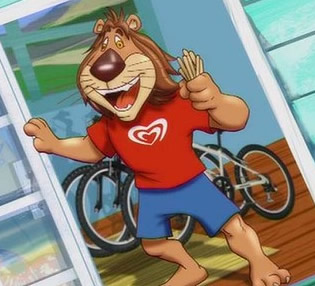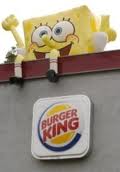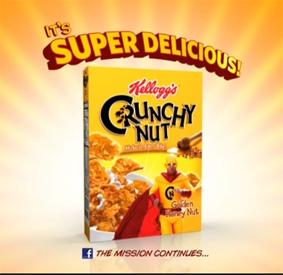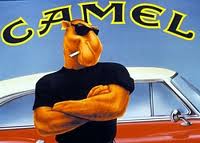 Cartoon and licensed characters are a highly successful marketing strategy when it comes to children, particularly the youngest children who can “form powerful bonds” with television, movie, radio and story book characters. Jennifer Blows of Kid Industries noted that babies as young as seven months old request products on the basis of characters on their packages: “The colours, form, shape and sounds all connect in some way to make meaning for the child and that meaning is, at this very early age, happiness and contentment. They feel secure. If your brand is able to offer that then you’re doing something very right indeed.”
Cartoon and licensed characters are a highly successful marketing strategy when it comes to children, particularly the youngest children who can “form powerful bonds” with television, movie, radio and story book characters. Jennifer Blows of Kid Industries noted that babies as young as seven months old request products on the basis of characters on their packages: “The colours, form, shape and sounds all connect in some way to make meaning for the child and that meaning is, at this very early age, happiness and contentment. They feel secure. If your brand is able to offer that then you’re doing something very right indeed.”
What is more small children often look up to fictional characters and tend to do what they ask of them. CMO magazine noted: “Marketers have found that putting a  cartoon character on just about anything can increase its sales. That’s why a growing number of consumer electronics companies are producing kid-branded items, from Barbie cell phones to Hello Kitty radios to TVs and DVD players branded with SpongeBob and other characters”.
cartoon character on just about anything can increase its sales. That’s why a growing number of consumer electronics companies are producing kid-branded items, from Barbie cell phones to Hello Kitty radios to TVs and DVD players branded with SpongeBob and other characters”.
Advertising consultancies seek to “build emotional connections with kids” by using characters that they hope will “draw kids in and engage them in the brand”. A workshop after the 2003 Kid Power Conference in Sydney focused on the use of characters in marketing to help brands “become a child’s ‘best friend’… Characters should capture the hearts and minds of children…”.
Chris McKee, from the Gepetto Group, denies that marketers use characters to sell brands to kids but admits: “What I love about characters is two- and three-year-olds develop such a strong affinity for them. You see the way they bond with these characters.” What marketers aim for is to have children, who may not even be able to speak yet, point to and demand products when they recognise a character or brand logo, and in this way get their mother to buy them.
 Advertisers feature cartoon or other characters to imply that those characters endorse their products. This is known as “host selling”. Around the world junk food is promoted with the use of popular characters such as Scooby Doo, Bob the Builder, and Nemo. A 1996 study of fifth grade boys found that 86 per cent of them recognised alcohol seller Budweiser’s cartoon frog, a recognition rate similar to that of Bugs Bunny. A later survey found that Budweiser was the favourite television advertisement for children.
Advertisers feature cartoon or other characters to imply that those characters endorse their products. This is known as “host selling”. Around the world junk food is promoted with the use of popular characters such as Scooby Doo, Bob the Builder, and Nemo. A 1996 study of fifth grade boys found that 86 per cent of them recognised alcohol seller Budweiser’s cartoon frog, a recognition rate similar to that of Bugs Bunny. A later survey found that Budweiser was the favourite television advertisement for children.
Youth Media Australia (YMA) found in a survey in 2005/6 that 87 per cent of  parents said their preschool children requested food that had TV or movie characters depicted on the packaging. Children often believe the things a favourite character says. For example a survey showed that more than half of Australian eight and nine year olds questioned believed Ronald McDonald knew best what children should eat.
parents said their preschool children requested food that had TV or movie characters depicted on the packaging. Children often believe the things a favourite character says. For example a survey showed that more than half of Australian eight and nine year olds questioned believed Ronald McDonald knew best what children should eat.
Advertisements are even placed in the breaks of the television programmes about those characters, thus blurring the distinction between programming and advertising and taking advantage of the affection children feel for those characters. Host selling is now banned in some places. Yet it is highly effective. In 1999 Burger King doubled its UK sales to 50 million over six weeks by giving away Teletubbies beanbag toys with its meals. (Teletubbies is a BBC-produced television programme aimed at toddlers.)

 Around 2000 children start smoking each day in the US and around one third of them will die as a result of it. After the cartoon character Old Joe Camel was introduced by Camel cigarettes, illegal sales to children skyrocketed from an estimated $6 million in 1988 to $476 million per year in 1991. One study found that a third of children who bought cigarettes despite being underage, bought Camel brand.
Around 2000 children start smoking each day in the US and around one third of them will die as a result of it. After the cartoon character Old Joe Camel was introduced by Camel cigarettes, illegal sales to children skyrocketed from an estimated $6 million in 1988 to $476 million per year in 1991. One study found that a third of children who bought cigarettes despite being underage, bought Camel brand.
In a study of children aged three to six years old, more than half were able to match the Joe Camel character to cigarettes. Other cigarette logos were matched by 18 per cent of children in one case and 33 per cent in another. The  older children (aged six) recognised Joe Camel 91 per cent of the time, a rate similar to that of Mickey Mouse for the Disney Channel. Considering tobacco advertising is not shown on television (apart from incidentally on sports broadcasts), their exposure to the Joe Camel character must come from movies, billboards, video arcade games, and licensed products such as t-shirts.
older children (aged six) recognised Joe Camel 91 per cent of the time, a rate similar to that of Mickey Mouse for the Disney Channel. Considering tobacco advertising is not shown on television (apart from incidentally on sports broadcasts), their exposure to the Joe Camel character must come from movies, billboards, video arcade games, and licensed products such as t-shirts.
Tobacco companies recognise children as a significant market, if not a current market then a potential market. Internal documents from Philip Morris stated “Today’s teenager is tomorrow’s potential regular customer … the smoking patterns of teenagers are particularly important to Philip Morris”. Documents from R.J. Reynolds showed that they viewed 14–18 year olds as an increasing market in which they needed to position themselves through the establishment of a new brand.